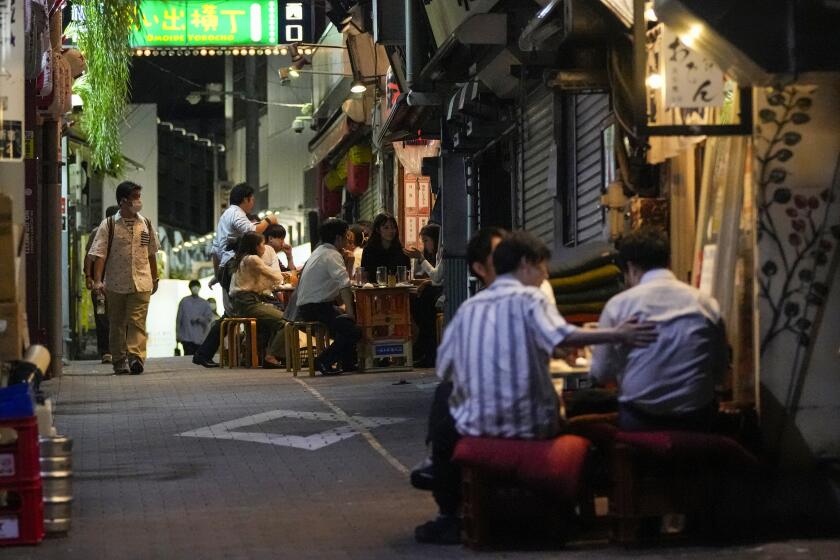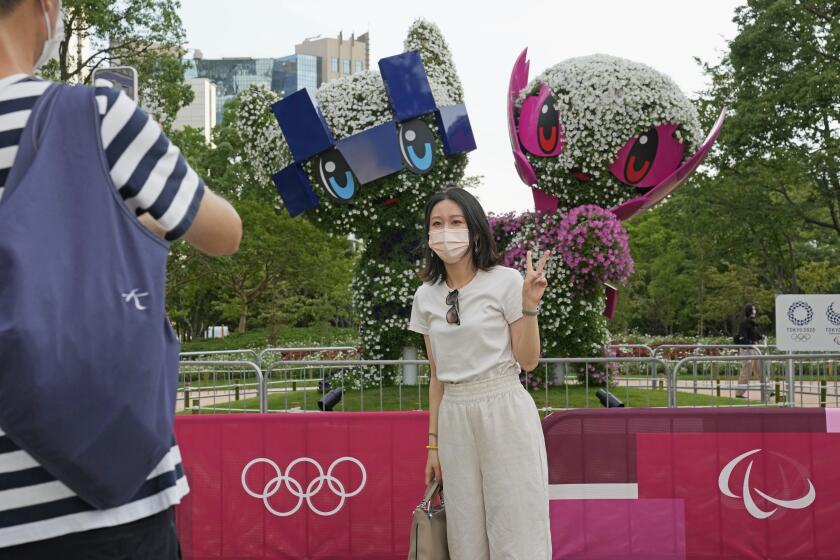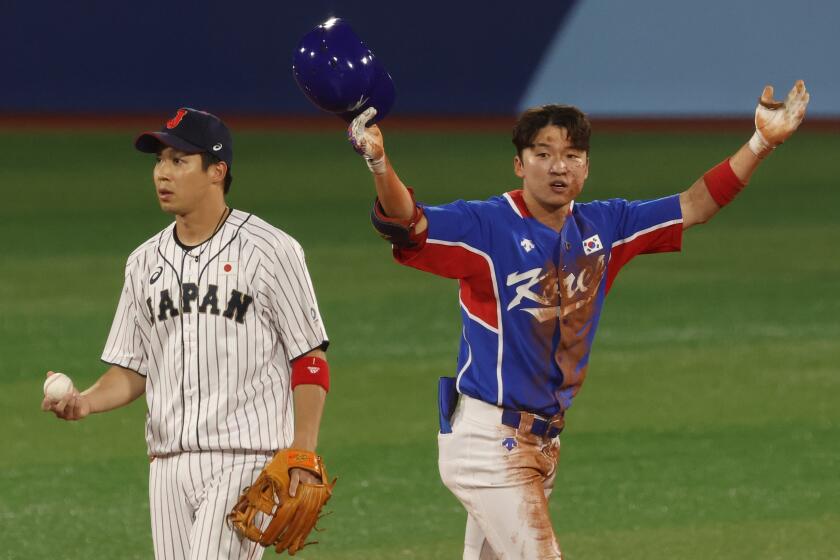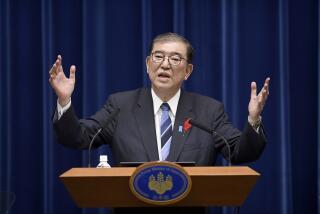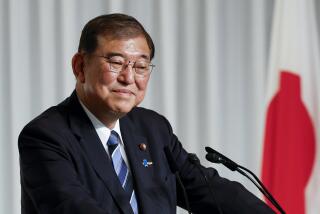Japan’s parliament elects former diplomat Fumio Kishida as new prime minister

- Share via
TOKYO — Japan’s parliament Monday elected Fumio Kishida, a former moderate turned hawk, as prime minister. He’ll face an economy battered by the pandemic, security threats from China and North Korea and the sagging ratings of a ruling party ahead of a fast-approaching national election.
With his Liberal Democratic Party and its coalition partner holding a majority in both houses, Kishida won by a comfortable margin against Yukio Edano, head of the largest opposition party, the Constitutional Democratic Party of Japan. After being sworn in at a ceremony in the royal palace, Kishida was to hold his first news conference as prime minister and chair his first Cabinet meeting later Monday.
He replaces Yoshihide Suga, who resigned after only one year in office as his support plunged over his government’s handling of the pandemic and insistence on holding the Tokyo Olympics as the coronavirus spread.
Kishida is expected to make a policy speech in parliament Friday but is looking to dissolve the lower house to hold elections Oct. 31, Japanese media reported. Observers see the early date as a move to take advantage of his government’s fresh image to rally support.
Jun Azumi, a senior Constitutional Democratic Party lawmaker, criticized Kishida over the reported plan to dissolve the house in just over a week. “It’s like a delicatessen that forces customers to buy without a chance to try samples,” Azumi said.
A former foreign minister, Kishida, 64, used to be known as a dovish moderate but turned hawkish apparently to win over influential conservatives in the party. He is firmly entrenched in the conservative establishment, and his victory in the party election was a choice for continuity and stability over change.
The Japanese government says its nationwide coronavirus state of emergency will end Thursday in order to help revive the economy as infections slow.
Kishida replaced all but two of Suga’s 20 Cabinet members, and 13 will hold ministerial posts for the first time, according to the lineup announced by new Chief Cabinet Secretary Hirokazu Matsuno. Most of the posts went to powerful factions that voted for Kishida in the party election. Only three women are included, up from two in Suga’s government.
Veteran female lawmaker Seiko Noda, one of four candidates who vied for the party leadership race, became the minister in charge of reversing the nation’s declining birthrate and of local revitalization. Another woman, Noriko Horiuchi, is the new vaccinations minister, replacing Taro Kono, the runner-up in the party leadership race.
Foreign Minister Toshimitsu Motegi and Defense Minister Nobuo Kishi, who is former Prime Minister Shinzo Abe’s younger brother, were retained, ensuring continuity of Japan’s diplomacy and security policies as the country seeks to work closely with Washington in the face of China’s rise and growing tensions in the region, including around Taiwan.
Kishida supports stronger Japan-U.S. security ties and partnerships with other like-minded democracies in Asia, Europe and Britain, in part to counter China and nuclear-armed North Korea.
Aggressive testing, tracking apps and restrictions prevented a widespread COVID-19 outbreak from derailing the Olympics, but there were problems.
Kishida created a new Cabinet post aimed at tackling the economic dimensions of Japan’s national security, appointing 46-year-old Takayuki Kobayashi, who is relatively new to parliament.
Finance Minister Taro Aso was shifted to a top party post and replaced by his 68-year-old relative, Shunichi Suzuki.
Japan faces growing nuclear and missile threats from North Korea, which last month test-fired ballistic missiles capable of hitting targets in Japan. Kishida also faces worsening ties with fellow U.S. ally South Korea over history issues even after he struck a 2015 agreement with Seoul to resolve a row over the issue of women who were sexually abused by Japan’s military during World War II.
South Korean President Moon Jae-in on Monday sent a letter to Kishida congratulating him on his election as prime minister and offering to work together to improve ties. In the letter, Moon said South Korea wants to strengthen cooperation on economy, culture, personnel exchanges and other sectors, Moon’s office said.
News Alerts
Get breaking news, investigations, analysis and more signature journalism from the Los Angeles Times in your inbox.
You may occasionally receive promotional content from the Los Angeles Times.
An urgent task at home will be turning around his party’s sagging popularity, hurt by Suga’s perceived highhandedness on the pandemic and other issues. Kishida is expected to make a policy speech this week before dissolving the lower house of parliament ahead of the general election expected by mid-November.
He’ll also have to ensure Japan’s healthcare systems, vaccination campaign and other virus measures are ready for a possible resurgence of COVID-19 in winter, while gradually normalizing social and economic activity.
Kishida said last week that his top priority would be the economy. Kishida’s “new capitalism” is largely a continuation of Abe’s economic policies. He aims to raise income of more people and create a cycle of growth and distribution.
Voters welcomed new, and slightly younger, faces in the new government.
A Japanese Salvadoran American Angeleno columnist and a Korean American Seoulite walk into a bar in Tokyo’s K-Town during the Korea-Japan Olympic baseball game. . .
Karen Einaka, a 28-year-old designer, said she hoped the new government takes into consideration younger people’s opinions and allows younger politicians to play important roles.
At least Kishida “looks more energetic than Suga,” said business owner Makoto Okubo.
A third-generation politician, Kishida was first elected to parliament in 1993 representing Hiroshima and is an advocate for nuclear disarmament. He escorted former President Obama during his 2016 visit to the city that, along with Nagasaki, was destroyed in U.S. atomic bombings in the closing days of World War II.
More to Read
Sign up for Essential California
The most important California stories and recommendations in your inbox every morning.
You may occasionally receive promotional content from the Los Angeles Times.
